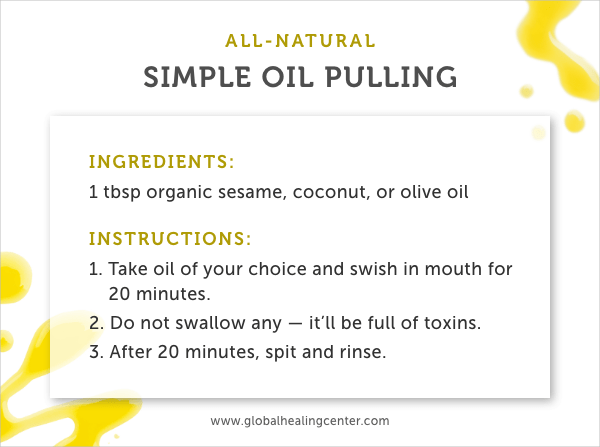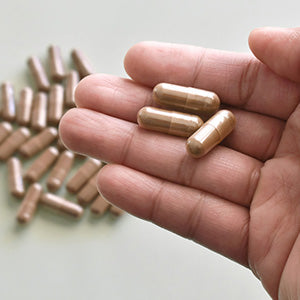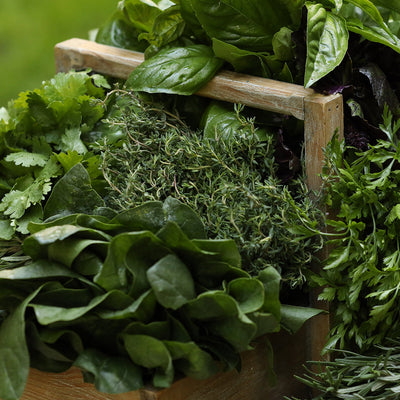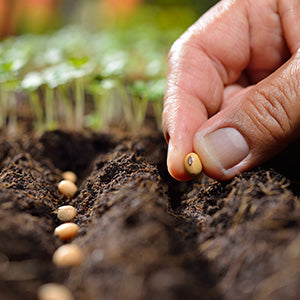Get a Brighter Smile With DIY Natural Teeth Whitening

Have you ever done the tissue test, where you hold up a piece of pristine white tissue paper next to your teeth to see the color difference? If you're like most people, the results are disheartening: stained, dull, yellow teeth — a far cry from the bright whiteness of the tissue.
Luckily, whitening your teeth doesn't have to be a big ordeal. There are plenty of do-it-yourself natural teeth whitening options, including herbs, activated charcoal, and more.
Plus, these methods are inexpensive and safe — unlike professional teeth whitening services and commercial teeth whitening products that are both damaging to enamel and pricey.
What Causes Yellow Teeth?
First of all, don't worry. Having yellow teeth doesn't necessarily mean you have any health concerns, it may just mean you're getting older. Aging teeth naturally have yellowing dentin — the dense tissue beneath the enamel. Because enamel wears away as you get older, your teeth appear more yellow with age.
Of course, other things may speed up the process. Smoking, for instance, is one of the top causes of discolored teeth.[1]. If you smoke, there are surefire ways to quit and make sure you kick the habit for good.
Non-smokers aren't necessarily free from worry, though. Many other factors cause yellow teeth, such as things you eat and drink, environmental factors like too much fluoride in your tap water, certain antibiotics (particularly tetracycline in children under eight), poor oral care in general, or just plain bad genes.[2]
Teeth Whitening Home Remedies
Whitening your teeth at home can be easy. With the right ingredients and methods, it can be an inexpensive, healthier, and less time-consuming process than professional teeth whitening products and services.
Don't neglect basic oral health: brush and floss your teeth regularly — in the morning, after each meal, and before bed. But here are a few do-it-yourself teeth whitening techniques you can add to your other oral hygiene habits.
Baking Soda
Traditionally, people have touted baking soda (sodium bicarbonate) as a natural way to whiten teeth, whether it's brushing with it directly or rinsing with a baking soda teeth whitening solution.
In 2008, researchers sought to validate a previous study showing that brushing with baking soda-enhanced toothpaste significantly decreased plaque on the surface of teeth. Guess what? It did.[3]
After not brushing for 24 hours, participants brushed their teeth with toothpaste containing 20 to 65 percent baking soda. After just a one-minute brushing, their teeth showed a substantial reduction in plaque compared with whitening toothpaste.[3] The results are likely due to the chemical composition of baking soda; sodium bicarbonate is relatively gritty, which enables it to remove surface stains — but not the deeper ones.
Some say that using baking soda for too long can damage the enamel, so be careful. Just do not press the baking soda too forcefully onto your teeth, and alternate your use of baking soda for a couple of weeks with regular toothpaste. After rinsing, use a soft-bristled brush, and rinse completely.
Recipe: DIY Baking Soda Toothpaste
Ingredients:
- 1 cup baking soda
- 12 drops food-grade organic peppermint essential oil (optional)
- Water to make a paste
Directions:
- To make an easy do-it-yourself toothpaste for your teeth, mix one cup of baking soda with just enough water to create a thick paste. Add 12 drops peppermint oil if desired.
- Spread a small amount of the paste all over your teeth, about the same amount as you do for regular toothpaste.
- Wait for a minute or two, then rinse. Alternatively, brush gently with a soft-bristled brush.
- Repeat this process every other day for a week.


Activated Charcoal
Activated charcoal teeth whitening powder or toothpaste is the latest craze in oral hygiene, and even though no scientific studies have yet proven its level of effectiveness, many people swear by it. We do know that, based on anecdotal evidence, toothpaste containing activated charcoal helps to remove surface stains.[4] Activated charcoal toothpaste may affect the surface roughness of the enamel so you may want to consider using the toothpaste or powder as a "mask" — leave it on your teeth for up to 5 minutes, and then rinse without scrubbing.
Some stores even carry toothbrushes with activated charcoal incorporated into the bristles, so you don't have to worry about messing around with powder or buying expensive pastes. Keep in mind, though, that any dental care product claiming it contains activated charcoal may also contain other whitening agents. Be sure to read labels carefully.
Recipe: Activated Charcoal Mask
Ingredients:
- Activated charcoal powder
Directions:
- Using your finger, gently rub a small amount of charcoal onto your teeth.
- Leave on for 3 to 5 minutes.
- Rinse thoroughly.
- Try it once a day for a few days, then take a break.


Your best bet here is to buy an organic powder from your local drugstore. Be aware, however, that activated charcoal can be abrasive and tooth enamel doesn't grow back. With that in mind, make sure you get activated charcoal that's not too abrasive. A good product will disclose its RDA (relative dentin abrasivity) — a score under 200 is where you want to be. Note the charcoal can stain your sink, floors, and clothing, so be cautious when using it.
Hydrogen Peroxide
Mothers have been telling their children for years: if you have a mouth infection or irritation, rinse it out with a hydrogen peroxide mixture. It may not taste good, but thanks to the chemical's antiseptic properties it helps to relieve discomfort and speed up wound healing.
You may not know that hydrogen peroxide also makes a great teeth whitening solution. In fact, most tooth-whitening products have hydrogen peroxide as the main ingredient. It essentially has a bleaching effect, breaking apart the stain compounds plaguing yellow teeth.[5] A hydrogen peroxide mouthwash is one of the quickest ways to use the chemical at home to whiten teeth.
Recipe: Hydrogen Peroxide Mouthwash
Ingredients:
- 1/4 cup 2-3.5 percent hydrogen peroxide (any higher percentage can cause serious dental and gum issues)
- 1/4 cup distilled water
Directions:
- Mix peroxide and distilled water.
- Swish some of the liquid around your mouth for about 30 seconds, spit, and rinse.
- Be careful not to swallow any of the mixture, as internal consumption is not recommended.
Save any extra in a glass mason jar in your refrigerator.


Turmeric
If you love yellow curry or golden milk — a warm turmeric drink — you may be surprised to hear that turmeric can whiten your teeth. Studies have found that turmeric and the curcuminoids it contains not only repel harmful organisms, but may also normalize levels of plaque in your mouth, which play a role in your teeth color.[6]
One study showed that a mouthwash mixture of turmeric and distilled water was effective against plaque.[6]
Recipe: Turmeric Mouthwash
Ingredients:
- 1 tsp turmeric powder from the grocery store
- 1 4-ounce glass of distilled water
Directions:
- Mix the turmeric into a glass of water.
- Swish a mouthful of the liquid in your mouth for 60 seconds.
- Spit the liquid into the sink.
Save the leftover mouthwash in the refrigerator.


Oil Pulling
Oil pulling sounds a lot more complicated than it actually is. Essentially, all you do is take some oil and swish it around in your mouth for an extended period of time. It's reportedly a boon for oral health, and a few studies have verified that — but not to the point where it's a go-to solution for yellowing teeth.[7]
Olive oil, sesame oil, and coconut oil are typically used for oil pulling.
One study shows that after 40 days of sesame oil pulling, participants had a 20 percent reduction in oral bacteria. For coconut oil teeth whitening, it reduced plaque and helped ease gingivitis; olive oil had the same effect.[7] The theory is that the oil is "pulling" bacteria out of your mouth, moisturizing your gums, and increasing saliva production.
You'll see your best results if you oil pull first thing in the morning on an empty stomach.
Recipe: Oil Pulling
Ingredients:
- 1 tablespoon organic sesame, coconut, or olive oil
Directions:
- Take one tablespoon of your oil of choice, swish it around your mouth for about 20 minutes, and make sure not to swallow any — it'll be full of toxins.
- When the time is up, spit your oil into the trash and brush your teeth.


Fruit-Based Teeth Whitening Methods
The methods above are far from the only folk remedies for naturally whitening your teeth. Some swear by apple cider vinegar and even brush their teeth with it every night; keep in mind that the acetic acid in vinegar can erode your enamel if you use too much, thus perpetuating the concern you're trying to avoid.
To use, smudge apple cider vinegar onto your teeth with your finger, let it sit for 20 minutes, and then brush your teeth normally.
People sometimes use citrus fruit peels (lemon, orange, and lime), ripe, brownish banana peels, or mashed, super-ripe strawberries (the riper, the better); smudge onto your teeth and leave them for five minutes for acidic citrus and berries and ten minutes for the acid-free banana peel. Again, brush your teeth thoroughly afterward, so the acid doesn't negatively impact your dental health. Repeat daily for two weeks.
An even easier method is just to eat pineapple; the fruit contains the powerful enzyme bromelain, a natural stain remover.
Traditional Teeth Whitening Methods
More commonly these days, people looking to have their teeth whitened are trying "traditional" methods — traditional meaning something you can purchase from a dentist or at the grocery store that's some sort of chemical compound targeting stained teeth. These remedies include:
- Professional whitening at a dentist
- Whitening strips
- Home bleaching systems
- Whitening gum
- Bleach gel
- Bleaching trays
- Whitening lights
- Whitening pens
Over time, these strategies have appeared effective when used under a trained dental professional's supervision. However, overuse or improper usage can severely damage your enamel.[8] Plus, these methods won't reverse tooth sensitivity and decay. And of course, if your teeth contain cavities, no whitening plan, natural or not, will be a substitute for proper dental care.
Prevent Stains in the First Place
When it comes to keeping your teeth shiny white, the best defense is a good offense. You can do plenty of things to slow the yellowing process we all naturally fall victim to as we age. Here are some quick tips.
- Try not to grind or clench your teeth; the damage causes them to yellow prematurely. Try a mouth guard if you are prone to nighttime tooth grinding.
- Wear a mouthguard during sports to avoid oral injuries.
- Limit your intake of coffee, tea, and red wine, but if you must have them, drink through a straw.
- Brush your teeth twice a day at least, floss at least once a day, and use mouthwash regularly.
- Avoid cigarettes, chewing tobacco, pipes, and other forms of smoking.
- Don't do drugs. While this is good advice in general, just know that they ruin your teeth prematurely.
- Get your teeth professionally cleaned every six months. However, tell your dentist not to use fluoride, which is toxic to your body.
- If you can, sleep with your mouth closed so that it doesn't dry out. Saliva cleans and protects enamel.
- Get enough calcium in your diet — it helps keep your jaw bone healthy.
Side Effects & Precautions
As with everything, using teeth whitening home remedies improperly, in the wrong concentrations, or using too much can do more harm than good. Abrasive products, like baking soda, can permanently damage your enamel or cause sensitive teeth.
Acidic things like citrus fruits or certain oils can do the same thing. Always be sure that you don't accidentally swallow whatever remedy you're trying — stuff like hydrogen peroxide can make you pretty sick if you ingest it.
Points to Remember
Natural teeth whitening is an excellent way to avoid the harsh and damaging chemicals from professional or "traditional" treatments. Just be sure you're trying each method properly and with restraint.
DIY baking soda toothpaste, activated charcoal scrubs, and oil pulling are some of the best ways to keep your teeth pearly white — making it possible to have whiter teeth without the chemicals and cost.
References (8)
- Alkhatib MN, et al. Smoking and tooth discolouration: findings from a national cross-sectional study. BMC Public Health. 2005 Mar 24;5:27.
- Tooth - abnormal colors. MedlinePlus, US National Library of Medicine. Accessed 6 Nov 2018.
- Putt MS, et al. Enhancement of plaque removal efficacy by tooth brushing with baking soda dentifrices: results of five clinical studies. J Clin Dent. 2008;19(4):111-119.
- Greenwall L, Wilson NHF. Charcoal toothpastes: what we know so far. Clinical Pharmacist. Aug 2017;9(8).
- Carey CM. Tooth whitening: what we now know. J Evid Based Dent Pract. 2014;14:70-76.
- Sood S, Nagpal M. Role of curcumin in systemic and oral health: an overview. J Nat Sci Biol Med. 2013;4(1):3.
- Shanbhag VKL. Oil pulling for maintaining oral hygiene – a review. J Tradit Complement Med. 2017;7(1):106-109.
- Tooth Whitening/Bleaching: Treatment Considerations for Dentists and Their Patients. American Dental Association Council on Scientific Affairs. Updated Nov 2010. Accessed 6 Nov 2018.
†Results may vary. Information and statements made are for education purposes and are not intended to replace the advice of your doctor. If you have a severe medical condition or health concern, see your physician.

Dr. Edward Group, DC
FOUNDER | HEALER | ADVOCATEDr. Group, DC is a healer and alternative health advocate, and an industry leader and innovator in the field of natural health who is dedicated to helping others. He is a registered doctor of chiropractic (DC), a naturopathic practitioner (NP), and proud alum of Harvard Business School and MIT Sloan School of Management. Dr. Group, DC is the founder of Global Healing – a mission and vision he has shared through best-selling books and frequent media appearances. He aims to spread his message of positivity, hope, and wellness throughout the world.










